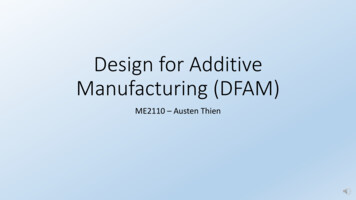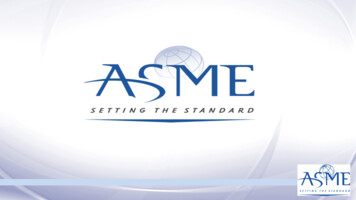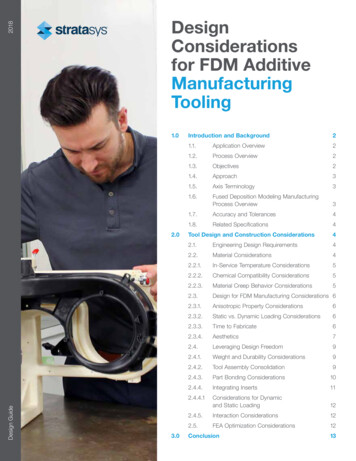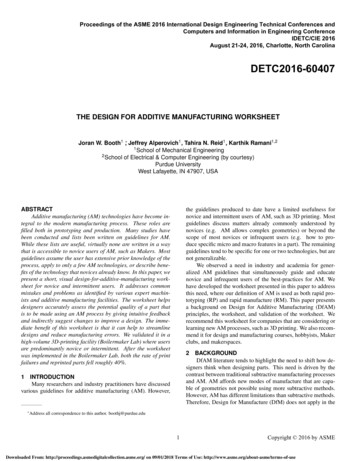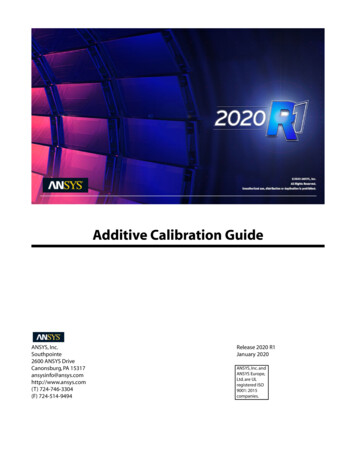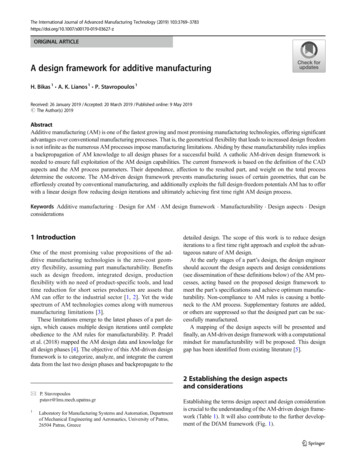
Transcription
The International Journal of Advanced Manufacturing Technology (2019) 03627-zORIGINAL ARTICLEA design framework for additive manufacturingH. Bikas 1 & A. K. Lianos 1 & P. Stavropoulos 1Received: 26 January 2019 / Accepted: 20 March 2019 / Published online: 9 May 2019# The Author(s) 2019AbstractAdditive manufacturing (AM) is one of the fastest growing and most promising manufacturing technologies, offering significantadvantages over conventional manufacturing processes. That is, the geometrical flexibility that leads to increased design freedomis not infinite as the numerous AM processes impose manufacturing limitations. Abiding by these manufacturability rules impliesa backpropagation of AM knowledge to all design phases for a successful build. A catholic AM-driven design framework isneeded to ensure full exploitation of the AM design capabilities. The current framework is based on the definition of the CADaspects and the AM process parameters. Their dependence, affection to the resulted part, and weight on the total processdetermine the outcome. The AM-driven design framework prevents manufacturing issues of certain geometries, that can beeffortlessly created by conventional manufacturing, and additionally exploits the full design-freedom potentials AM has to offerwith a linear design flow reducing design iterations and ultimately achieving first time right AM design process.Keywords Additive manufacturing . Design for AM . AM design framework . Manufacturability . Design aspects . Designconsiderations1 IntroductionOne of the most promising value propositions of the additive manufacturing technologies is the zero-cost geometry flexibility, assuming part manufacturability. Benefitssuch as design freedom, integrated design, productionflexibility with no need of product-specific tools, and leadtime reduction for short series production are assets thatAM can offer to the industrial sector [1, 2]. Yet the widespectrum of AM technologies comes along with numerousmanufacturing limitations [3].These limitations emerge to the latest phases of a part design, which causes multiple design iterations until completeobedience to the AM rules for manufacturability. P. Pradelet al. (2018) mapped the AM design data and knowledge forall design phases [4]. The objective of this AM-driven designframework is to categorize, analyze, and integrate the currentdata from the last two design phases and backpropagate to thedetailed design. The scope of this work is to reduce designiterations to a first time right approach and exploit the advantageous nature of AM design.At the early stages of a part’s design, the design engineershould account the design aspects and design considerations(see dissemination of these definitions below) of the AM processes, acting based on the proposed design framework tomeet the part’s specifications and achieve optimum manufacturability. Non-compliance to AM rules is causing a bottleneck to the AM process. Supplementary features are added,or others are suppressed so that the designed part can be successfully manufactured.A mapping of the design aspects will be presented andfinally, an AM-driven design framework with a computationalmindset for manufacturability will be proposed. This designgap has been identified from existing literature [5].2 Establishing the design aspectsand considerations* P. Stavropoulospstavr@lms.mech.upatras.gr1Laboratory for Manufacturing Systems and Automation, Departmentof Mechanical Engineering and Aeronautics, University of Patras,26504 Patras, GreeceEstablishing the terms design aspect and design considerationis crucial to the understanding of the AM-driven design framework (Table 1). It will also contribute to the further development of the DfAM framework (Fig. 1).
3770Int J Adv Manuf Technol (2019) 103:3769–3783Table 1 NomenclatureAcronymDefinitionMeaningAMDfAMAdditive manufacturingDesign for additive manufacturingDesign aspectUnconventional manufacturing technologyA generic term used to describe rules andparameters for a part design to be producedwith an AM processPart’s feature or process’s parameterDesign considerationAny resulted outcomeFig. 1 Defining Aspects andConsiderations for AM DesignDesign aspect is defined as any particular feature which canbe quantified at the design phase. That includes geometricfeatures of the part’s shape (overhangs, bores, channels, etc.)and part’s programming parameters (layer thickness, orientation, etc.).Design consideration is the result on the manufactured part.These considerations can be very specific properties of theprocess and quantified with certain KPIs. That is, a designconsideration can be a mere generic goal of the AM processsuch as achieving a first time right manufactured part or aspecific one like part surface roughness.Following the establishment of these terms, comesthe categorization of the current DfAM academic publications and tacit industrial knowledge in datasheets withall their parameters quantified. The next step is to develop a design framework of the bellow, dense in information blocks to extract manufacturability knowledgeand thus morph the optimum part design. With conventional manufacturing processes, these aspects are mostlya concern for the production engineer rather than for theindustrial designer; yet, the significance of these aspectsis high for the outcome in AM technologies [4].2.1 Design aspectsThe design aspects of the AM process, presented below, areorganized in two main categories: part’s geometric featuresand process parameters.2.1.1 Geometric featuresFig. 2 Build vector depicted on a PBF AM machine (adapted from [7])Similar to conventional manufacturing, there are restrictionsregarding the geometries that can be built. The layer-by-layer
Int J Adv Manuf Technol (2019) 103:3769–37833771Fig. 3 Overhanging geometries created with PBF AM technologies [8]Fig. 4 Overhanging geometriescategoriesprinciple followed by AM machines has its limitations sinceeach layer must be built directly above the previous one [6].That is, not every geometry is possible as each geometricalfeature must obey to a certain geometrical continuity. Oncethis geometric continuity is overlooked in the design, theresulting part will suffer in its integrity (e.g., deformation,porous mass, reduced density). The design aspects that determine the quality of the outcome are presented in the followingchapters.Overhanging geometries Manufacturing overhanging geometries is a trite, yet challenging feature for the majority of the0Manufacturability for conventional process is a duality. A feature can orcannot be manufactured. Yet for AM process, there are intermediate stateswhere a feature can be manufactured with the aid of support structuresAM processes. A generic definition of an overhanging geometry is any geometry whose orientation is not parallel to thebuild vector (Fig. 2). The ability of the AM machine to manufacture a layer of material displaced to the previous, definesits ability to create overhanging geometries. The magnitude ofthis layer’s parallel shift sets the limit for the maximum overhang length and the maximum slope angle.However, overhanging geometries can be successfullymanufactured, with the addition of support structures; yet,they might be proven of poor layer adhesion or postprocessing demanding (Fig. 3) [9, 10]. A support structureguarantees a successful build yet compromises the surfacequality of the part, reason for being the support structuresand part are overlapped [10]. It also decreases the efficiencyof the AM process-build time, material, post-processingequipment, and process cost and contradicts its advantageous
ydepositionPowder eedBinder jettingOverhang limit per AM TechnologyVatPolymerizationTable 2Int J Adv Manuf Technol (2019) s[14][14]net-shape manufacturing nature. Therefore, in order to increase AM manufacturability,1 it is desirable that the part onlyhas self-supported geometrical features.The most important overhanging geometries that need toabide AM limits are presented (Fig. 4).Overhangs Overhangs are one-sided abrupt geometrychanges. The horizontal distance an AM machine can buildwithout supports is limited and if exceeded, the wholebuild could fail. The limit of an overhang length is affectedby numerous factors and the nature of the AM technology[11–13]. As discussed above, the AM process, the materialused, and even the actual machine are variables to theequation that defines the maximum overhang length.Fig. 5 Overhang’s decisionmaking schematic[15]When part specifications call for a greater overhang, thedecision to be made is whether to alter the part’s geometryor maintain it and add supporting structures. Indicativeoverhanging lengths are presented in Table 2. The simplestway to resolve this is to replace horizontal overhangs withangled ones. In case that an angled overhang adaption isnot feasible, due to the specifications and the geometry ofthe part, a support structure needs to be introduced to support the overhanging feature. The design decision-makingprocess regarding horizontal overhangs is summarized inFig. 5.Angled overhangs Another category of the overhanging geometries is the angled overhang. In correlation with the length
Int J Adv Manuf Technol (2019) 103:3769–3783N/ASheetLOMLENSEBMPowder der degrees)Angled overhangsNoNeedDirect energydepositionAngled overhangs for AM technologiesVatPolymerizationTable 33773N/A[15][20]60 55 [14]45 Supports[14][14][15]of the overhangs, the overhanging angle of angled overhangsis also a geometrical limiting factor to most AM technologies .Some AM technologies can produce angled overhangs of certain gradient where others cannot (Table 3). These numberscan diverge highly in certain parts whose surface quality isacceptable to be poor and if the process parameters have beenset up correctly [21].For extrusion AM technologies, extreme angled overhangscannot be created as material cannot be deposited in midair[12]. For powder bed fusion AM technologies, the powdersurrounding the part acts as a support and thus, steeper angledoverhangs can be realized. That is, there is a drawback regarding surface roughness as the surrounding powder is sinteredunevenly on the downward facing areas of the part.(a)Bridging Similar to overhangs, a bridge is a horizontal geometry between two or more non-horizontal features (Fig. 6). Abridge is defined as any surface in the part geometry that isfacing down between two or more features. Related to theprevious restrictions, the designer must take into considerationthe maximum length that the machine can bridge. If this lengthexceeded, the part will not be successfully manufactured(Table 4).Bores and channels Manufacturing parts with internal geometries is a major benefit and desirable feature for AM technologies. Manufacturing internal bores that are impossible withtraditional manufacturing methods is feasible with AM, without additional cost [23]. That enables profound geometrical(b)ver cal surfaces[Low]down-facing surfaces[90 -180 ]up-facing surfaces[0 -90 ][High]Surface RoughnessFig. 6 (a) Overhanging angles in a test part manufactured with SLM technology, modified from [18]. (b) Overhanging angle‐surface roughness, adaptedfrom [22]
er /ABinder jettingBridging length for AM technologiesVatPolymerizationTable 4Int J Adv Manuf Technol (2019) upports80[14][14]*DED technologies can bridge long distances if the head is operated with a robotic arm (counter to operation on a CNC table), as with the armsorientation freedom bridging a horizontal feature can be manufactured as a vertical one.flexibility allowing the creation of parts with internal concavechannels—achieving great heat convention capabilities or optimum fluid flow [24, 25]—or structural reinforcement—lattice structures [26, 27]. The major AM advantage of conformal cooling channels that follow complex paths throughthe volume of the part increases the heat transfer capacitywhich in mold manufacturing processes provides efficientcooling to mold cavities and reduces cooling time [24].To properly implement these advantageous features in theAM part design, compliance with the AM design aspects limitsis mandatory. Bores and channels are subject of theFig. 7 Bores or channels aresubjects overhanging geometrywhen perpendicularlymanufacturedoverhanging geometries, acting as partially overhanging cavities (Fig. 7). That is, their limits are sometimes different as seenin Table 5.Wall thickness There is a minimum wall thickness that is feasible to be manufactured for each AM process. This is due tothe building threshold determined by the fundamental unit ofthe AM machine—diameter of laser beam, flow focal point, ornozzle—and the fact that the machine needs to make multiplepasses to build a sufficient and solid feature. Indicative minimum wall thicknesses are shown in Table 6. Another
Min. wall sitionPowder der bedfusionBinder inder umdiameter(mm)DLPTable 6SLATable 5SLA(mm)Bores and channelsInt J Adv Manuf Technol (2019) 103:3769–37833775Bores and channel’s dimension limits for AM Minimum wall thickness for AM technologiesN/AN/AN/AN/A
3776Int J Adv Manuf Technol (2019) 103:3769–3783accountable parameter for thin walls is the height-to-thicknessratio. Oblong wall structures tend to collapse.2An important path planning aspect when designing thinwalls, close to the limits of the AM machine, is that somegeometries cannot be precisely depicted as the slicing software which generates the G-code is not able to create thedesired geometry (Fig. 8) [28, 29].Below the lower limit of the allowed thickness, the wallfeature cannot be formed, or when formed, will sufferfrom deformation [30]. An integer multiple of the fundamental tool path width must be used for the design. Whenthe geometry’s width that must be manufactured is not aninteger multiple of the fundamental tool path width, theslicer software will have to compensate for that issue.Some of the most common ways to tackle this is to skipor overlap a certain line of the sliced surface. Anotherapproach is to try and alter the tool path width. Thesesolutions are, for the most part, insufficient as the integrityof the part is compromised or a generic parameter of themachine deviates from the optimum. This could cause adeviation of the dimensional accuracy and the mechanicalproperties.A filling indicator is introduced to determine whether thepath plan creates a sufficiently dense part.Fig. 8 Different path line’s width for path planning for a given energydepositionSheetEBMLENSEBAMLOMPowder ionFDMCDLPDLPSLA(mm)Smallest feature0.1Binder jettingSmallest geometrical feature for AM technologiesVatPolymerizationTable 7N/AN/AN/AN/A
Projector Projector NozzleLaser spot Laser BeamNozzle WireSingleJetPrint headInkjet,Line-wise Headsbevoxels lightandspotbeammoving pointnodiamediameterwithdepositingpolymer1Dam1024 780 source 0.15–1.0 mm scanpowdersize 0.3–0.5zzltermultiple 5000 5000 dpi 80 μm binderdepositiparticle0.2–1- LPCDLPFDMMJNPJDODBinder jettingMaterial jettingExtrusionVat polymerizationFundamental build unit per AM technologyTable 8Fundamental Laserunitspot130–150μmLOMEBAMLENSMJFSLM EBMDirect energydepositionPowder bed fusionSheetInt J Adv Manuf Technol (2019) 103:3769–37833777FI ¼D f LiAcsð1Þwhere Df is the diameter of the fundamental build unit, Li thelength of each path, and Acs is the surface area of the crosssection.There are physical constrains when building thin wallsas they are difficult to form and can be easily distorted [31,32]. The successful manufacturing of a thin wall is notalways a hardware concern. The slicing software determines the G-code for the AM machine’s fundamental building unit to follow, which can bottleneck the build [33]. Athin feature can be overlooked by the slicing software, although the machine can manufacture that feature in certainoptimum scenarios [29].Smallest features Apart from the minimum wall thickness,which is considered a 1D thin feature, there are more smallfeatures that challenge the ability of the AM machine whenit comes down to manufacturability [34]. A 2D thin featurean AM machine can manufacture is usually referred to thediameter of the smallest possible pin [29]. It could alsorefer to the side of a rectangular or a complex-curved geometry. This aspect should be considered at the designphase, as it defines the detail that can be introduced to thepart. The smallest features of AM technologies can be seenin Table 7.2.1.2 Process parametersProcess parameters are selected at the slicing phase3 of theAM process. They are highly interconnected with the AMtechnology and the individual machine. The proper AM design considers the build orientation and the layer thickness. InTable 8, the fundamental AM machine units that build the partlayer-by-layer are presented.Layer thickness Layer thickness is a factor that affectsboth the quality of the print and the build time neededto complete the part. With smaller layer thickness, amore detailed part is produced, and the staircase effectis minimized. Additionally, with smaller layer thickness,potential voids and gaps are eliminated, as the CAD fileis being sliced with more precision and the geometryaccuracy is maintained. On the counterpart, with thickerlayers, the printing time is reduced [35]. Regarding thestaircase effect, another factor that is causing it is theslope angle. As the angle increases, the cosine is proportionally increasing the stair size [36]. Indicating layerthicknesses for AM technologies are presented inTable 9.
wderbed PSLAMSLA[37]DLP(μm)Layer thickness1Binder jettingLayer thickness for AM technologiesVatPolymerizationTable 9Int J Adv Manuf Technol (2019) 0[38]1301503804001000A proposed solution to this matter is adaptive slicing.The areas where detail is needed are sliced with thinlayer height, whereas areas that their quality is not affected are sliced with thicker layer height to contribute to aneffective build regarding time and energy consumption[39].Build orientation The build orientation is one of the mostcrucial process parameters. The orientation of the part relative to the build vector of the fundamental build unitdetermines which geometrical features are overhanginggeometries. Subsequently, the build orientation determinesthe volume of support structures needed to successfullymanufacture the part [40, 11]. Moreover, it sets the axison which the mechanical properties show anisotropicbehavior.2.2 Design considerationsAs defined at the beginning, a design consideration is anyresulted affection on the finished product. That includesmechanical properties of the part, KPIs of the AM processor even more abstract goals like first time right design andmanufacture. Presented below are the most important design considerations.2.2.1 Anisotropic mechanical propertiesAM technologies produce parts with anisotropic mechanicalproperties. The anisotropic behavior is rooted to the AM nature and can be traced back to four different causes: lamellarnature, cylindrical extrusion shape (FFF technologies), shortfibers within the raw material, and scaffold and lattice
Int J Adv Manuf Technol (2019) 103:3769–37833779Fig. 9 a The lamellar nature. bCylindrical extrusion shape of theFDM process. c Short fiberalignment during the extrusionprocess of a composite. d Latticestructures [41]structures within the volume of the part (Fig. 9) [41, 49].Mitigating the anisotropy with heat treatment improves tosome extent the mechanical properties. However, it is notfeasible for components that cannot fit to a furnace, thus itneeds to be pointed as a design consideration for AM.Having said that, there are two approaches to design a partwith a given load case. The first one is to orient the designedpart in such a way that the loads are received in the directionwhich the AM technology has the greatest mechanicalstrength. The other, more sophisticated approach is to shapeoptimize the part with the mechanical strength anisotropy inmind [41, 43].Table 102.2.2 Accuracy (xy plane vs z axis)Another important design consideration is to distinguishbetween the machine’s accuracy on the xy plane and zaxis. The accuracy of the machine that will produce thedesired part is crucial for the designer at the designingphase. For pre-assembled builds or assemblies in general,the dimensional accuracy with which the machine canmanufacture has to be considered for the build to be asuccess.Surface quality for AM technologiesRaVat polymerization Extrusion Material jetting(μm)SLA DLP CDLP FDMSurface roughness 1.69102025356191RoughMJ NPJ DODBinder jetting Powder bed fusionDirect energydepositionMJF SLS SLM EBM LENS[38][44][38][44][38]EBAMSheetLOM
AdhesionHeatconvectionAdhesionand heatconvectionAdhesionand heatconvectionAdhesionand heatconvectionAdhesionand heatconvectionLENSEBMSLMSLSMJFDirect energydepositionNPJMJFDMSLADLPCDLPExtrusion Material jettingVat polymerizationAdhesion Adhesion Adhesion Adhesion Adhesion Adhesion AdhesionBasecross-sectionTable 11Base cross-section requirement per AM technologyDODBinderjettingPowder bed fusionEBAM LOMInt J Adv Manuf Technol (2019) 103:3769–3783Sheet37802.2.3 Surface roughnessThe roughness of the completed part is important, as itdetermines the post-processing steps in order to achievethe desired surface quality. The resulted surface roughness is not uniform throughout the entire surface of theprinted part. This is caused by the geometry’s slopeangle and the unintentional sintering under angled overhangs [19]. Another reason for surface non-uniformity isthe gaps resulted from insufficient filling of the pathplanning (see chapter “Wall thickness”). Chryssolouriset.al. [43] have estimated the average surface roughnessof SLA-produced parts as a function of the layer thickness and the angle of the inclined surface. Indicativesurface roughness for AM technologies are presentedin (Table 10).2.2.4 Build timeThe build time refers to the total time required for an AMmachine to manufacture the part. The build time and buildorientation of the part are highly related that is due to the factthat material deposition speeds on xy plane and z axis are notthe same. The build unit (e.g., nozzle, laser) moves, thusbuilds the part, with greater speed on the xy axis, then thespeed that the layers are adding up [45]. Changing the buildorientation will affect the time needed for the AM machine tocomplete the part. Horizontally orientated parts will in generalbe printed faster than vertically orientated ones.2.2.5 Part’s cross-section areaThe part’s cross-section area (normal to build vector) is animportant design consideration. The cross-section area affectsthe manufacturing process in two ways depending on the AMtechnology. The first one is related with the machine’s buildbase. The second one is related with the stresses that are developed at the rest of the part’s volume while its layers aremanufactured. The second design consideration of the developed stresses on the part’s cross-section area is related to itsmechanical properties [41].Machine’s build plate and part’s base consideration The firstlayers of the build are crucial for its completion. The part mustbe restrained at the build plate; thus, the adhesion between thepart’s base surface and the machine’s plate is to be considered,apart from securing the part, through that common surfaceheat dissipation is achieved [46]. A thermal simulation forthe heat concentration provides a picture for the design engineer, regarding residual stresses [47] The function that thepart’s base cross-section has per AM technology is presentedin (Table 11).
Int J Adv Manuf Technol (2019) 103:3769–3783Table 123781AM technologies that require small cross section area throughout the buildVat polymerization Extrusion Material jettingSLA DLP CDLP FDMDevelops residualNOstresses at cross-sectionBinder jetting Powder bed fusionMJ NPJ DODMJF SLS SLMModeratePart’s cross-section and developed stresses consideration Forthe AM technologies that develop residual stresses (Table 12)(e.g., PBF, extrusion), it is desirable to maintain a small crosssection area to minimize residual stresses and thus deformation. This effect has a greater impact to more delicate andelongated structures such as CMF implants [48].Lacking a coherent DfAM framework, the design processcalls for numerous design iterations due to redesigning needsfor adaptation to AM technologies [49]. To compensate that, areplacement of the infinite-freedom design mentality with theAM design aspects presented above, is needed. Methodicallymorphing the part’s geometry, based on the design aspects, thedesign process becomes linear.YesDirect energydepositionSheetEBM LENS EBAM LOMYes Significant YesYesYesYesfully utilizing the AM process’s advantageous nature and anticipate the manufacturability limits of the AM technologythat will manufacture the part.This is achieved with the backpropagation of the processand manufacturing information, which morphs the shape andcharacteristics of the design, resulting in a part that abides theDfAM rules from the first design iteration (Fig. 10). That is,the design process is made in a more linear fashion, eliminating time-consuming design iterations.The previous approach for the AM-driven design framework makes the design process computation orientated.4 Final considerations3 Approach: mapping design stepsand defining the frameworkThe approach proposed in this paper uses the AM designaspects and considerations to define the part’s geometrythroughout the design phases. This methodology is aimed atWhen designing a part to be realized with an AM process,certain design aspects and considerations need to be taken intoaccount. The existing design for manufacturing rules (DFM)for conventional processes contribute to the designer’s psychological inertia, which drives the part design away from theAM advantageous nature. The layer-wise nature of all AMBack-propaga on of DfAM informa era lityCheckTRUEMANUFACTURINGFig. 10 Conventional (orange) and proposed (blue) design process for AM
3782technologies comes along with specific geometrical limitations. Determining all design aspects that define a part’s geometry and then quantifying their affection on the outcome isa necessity in order to optimize the AM process. The initialstep of creating such a design framework for additivemanufacturing technologies was to accurately define the design aspects, design considerations, and their dependence.Working the part design as proposed above is of dual usefulness. First, it optimizes the conventional design process(geometry imposed by a human designer). The second contribution of this framework is related with the generative designshape optimizers. Although at their early stages, generativedesign seems to promise the future for part and assemblydesigns. The current quantification of design aspects and considerations and their true or false affection on AM manufacturability will secure the creation of optimized design that is atthe same time AM ready to manufacture.To drastically improve the AM production’s efficiency, thecomplete design flow (conceptual, embodiment, and detaildesign) needs to be created with AM DfAM in mind. Onlythen, the AM technologies will be able to have their advantageous nature fully exploited.Int J Adv Manuf Technol (2019) 103:3769–3783References1.2.3.4.5.6.7.8.5 Further workThis AM-driven design framework bridges the gap existingbetween the generic DfAM knowledge and the computationalapproach with the AM factors’ parameterization. This unlocksthe opportunity to paths where the weight of the factors andthe method of the design process is implemented with dataanalytic methods. The AM designer’s need for precognitioncan be replaced with intergraded ML algorithms that determine the optimum process parameters. Additionally, themorphing and manufacturability of the design can now berealized with shape algorithms. This AI approach to the AMdesign needs multiple data inputs from real-life manufacturing. The drift in manufacturing industry towards live processmonitoring and communication between the different stagesof production (IOT) serves the need for actual data to optimizethe design algorithms based on the outcome result.Funding The research leading to this paper has received funding fromthe European Union’s Horizon 2020 research and innovation programme,under the AMable (AdditiveManufacturABLE) project, grant agreementno 768775.Open Access This article is distributed under the terms of the CreativeCommons Attribution 4.0 International License (http://creativecommons.org/licenses/by/4.0/), which permits unrestricted use,distribution, and reproduction in any medi
Keywords Additive manufacturing . Design for AM . AM design framework . Manufacturability . Design aspects . Design considerations 1 Introduction One of the most promising value propositions of the ad-ditive manufacturing technologies is the zero-cost geom-et
